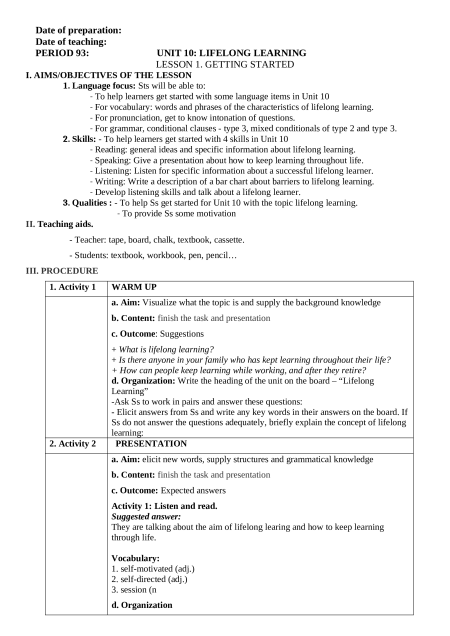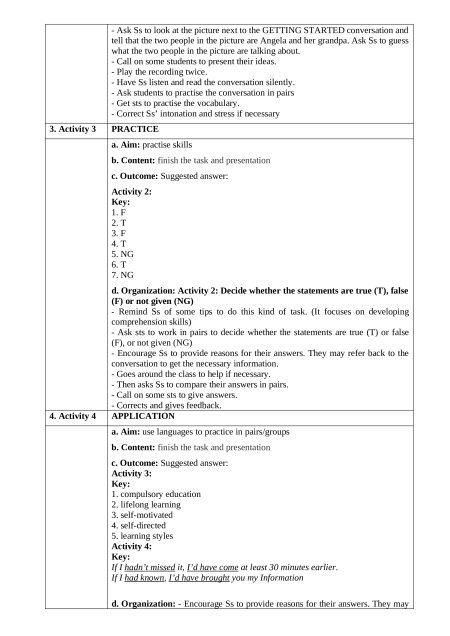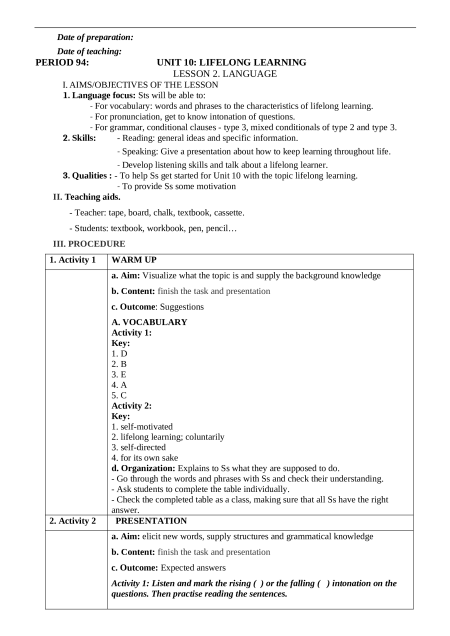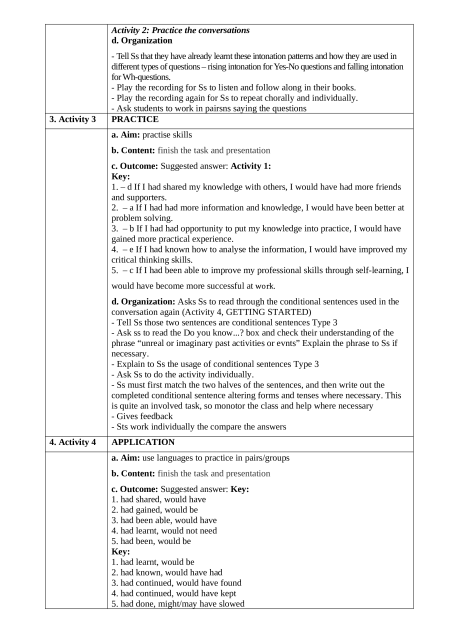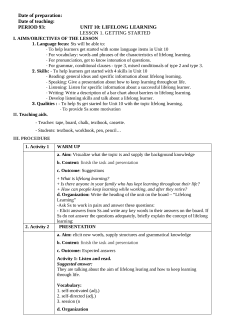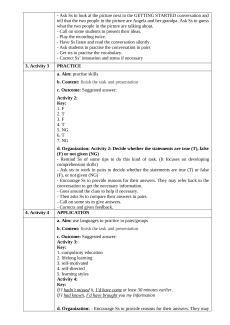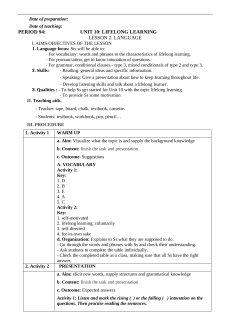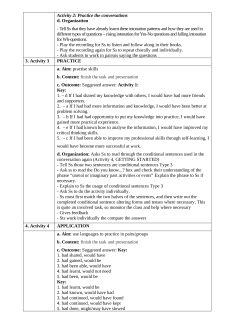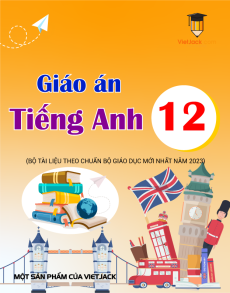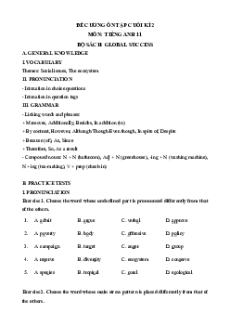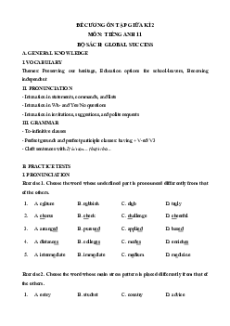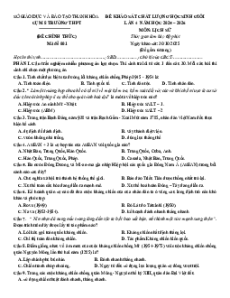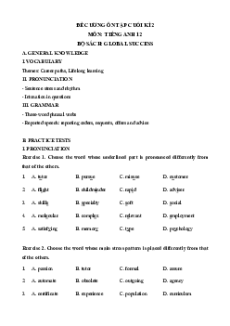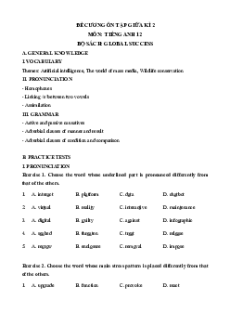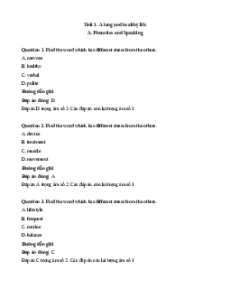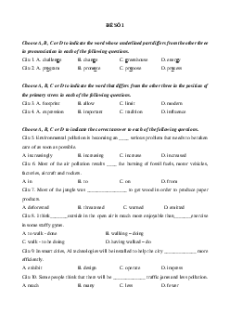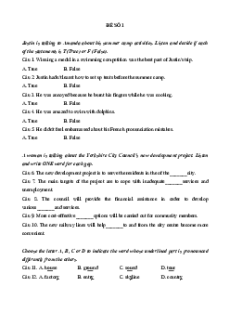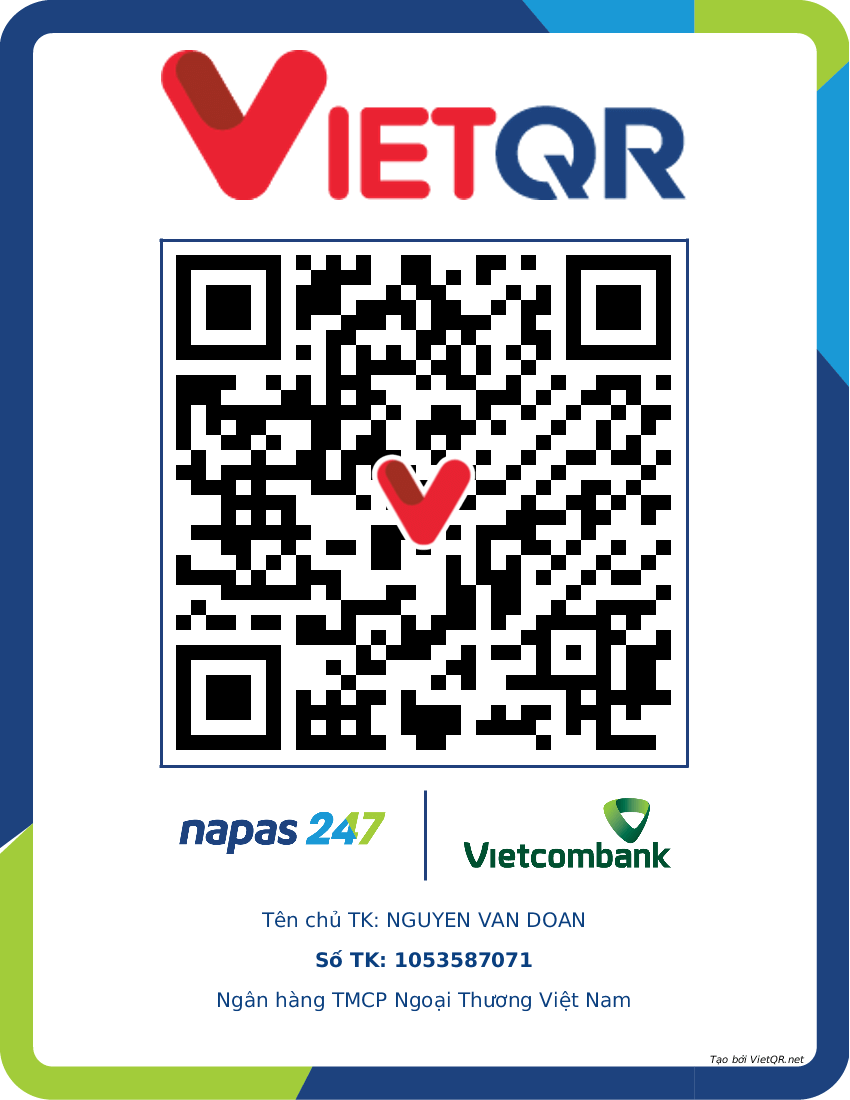Date of preparation: Date of teaching: PERIOD 93:
UNIT 10: LIFELONG LEARNING LESSON 1. GETTING STARTED
I. AIMS/OBJECTIVES OF THE LESSON
1. Language focus: Sts will be able to:
- To help learners get started with some language items in Unit 10
- For vocabulary: words and phrases of the characteristics of lifelong learning.
- For pronunciation, get to know intonation of questions.
- For grammar, conditional clauses - type 3, mixed conditionals of type 2 and type 3.
2. Skills: - To help learners get started with 4 skills in Unit 10
- Reading: general ideas and specific information about lifelong learning.
- Speaking: Give a presentation about how to keep learning throughout life.
- Listening: Listen for specific information about a successful lifelong learner.
- Writing: Write a description of a bar chart about barriers to lifelong learning.
- Develop listening skills and talk about a lifelong learner.
3. Qualities : - To help Ss get started for Unit 10 with the topic lifelong learning.
- To provide Ss some motivation II. Teaching aids.
- Teacher: tape, board, chalk, textbook, cassette.
- Students: textbook, workbook, pen, pencil… III. PROCEDURE 1. Activity 1 WARM UP
a. Aim: Visualize what the topic is and supply the background knowledge
b. Content: finish the task and presentation c. Outcome: Suggestions
+ What is lifelong learning?
+ Is there anyone in your family who has kept learning throughout their life?
+ How can people keep learning while working, and after they retire?
d. Organization: Write the heading of the unit on the board – “Lifelong Learning”
-Ask Ss to work in pairs and answer these questions:
- Elicit answers from Ss and write any key words in their answers on the board. If
Ss do not answer the questions adequately, briefly explain the concept of lifelong learning: 2. Activity 2 PRESENTATION
a. Aim: elicit new words, supply structures and grammatical knowledge
b. Content: finish the task and presentation
c. Outcome: Expected answers
Activity 1: Listen and read. Suggested answer:
They are talking about the aim of lifelong learing and how to keep learning through life. Vocabulary: 1. self-motivated (adj.) 2. self-directed (adj.) 3. session (n d. Organization
- Ask Ss to look at the picture next to the GETTING STARTED conversation and
tell that the two people in the picture are Angela and her grandpa. Ask Ss to guess
what the two people in the picture are talking about.
- Call on some students to present their ideas. - Play the recording twice.
- Have Ss listen and read the conversation silently.
- Ask students to practise the conversation in pairs
- Get sts to practise the vocabulary.
- Correct Ss’ intonation and stress if necessary 3. Activity 3 PRACTICE a. Aim: practise skills
b. Content: finish the task and presentation
c. Outcome: Suggested answer: Activity 2: Key: 1. F 2. T 3. F 4. T 5. NG 6. T 7. NG
d. Organization: Activity 2: Decide whether the statements are true (T), false (F) or not given (NG)
- Remind Ss of some tips to do this kind of task. (It focuses on developing comprehension skills)
- Ask sts to work in pairs to decide whether the statements are true (T) or false (F), or not given (NG)
- Encourage Ss to provide reasons for their answers. They may refer back to the
conversation to get the necessary information.
- Goes around the class to help if necessary.
- Then asks Ss to compare their answers in pairs.
- Call on some sts to give answers. - Corrects and gives feedback. 4. Activity 4 APPLICATION
a. Aim: use languages to practice in pairs/groups
b. Content: finish the task and presentation
c. Outcome: Suggested answer: Activity 3: Key: 1. compulsory education 2. lifelong learning 3. self-motivated 4. self-directed 5. learning styles Activity 4: Key:
If I hadn’t missed it, I’d have come at least 30 minutes earlier.
If I had known, I’d have brought you my Information
d. Organization: - Encourage Ss to provide reasons for their answers. They may
refer back to the conversation to get the necessary information.
- Goes around the class to help if necessary.
- Then asks Ss to compare their answers in pairs.
- Call on some sts to give answers. - Corrects and gives feedback. Date of preparation: Date of teaching: PERIOD 94:
UNIT 10: LIFELONG LEARNING LESSON 2. LANGUAGE
I. AIMS/OBJECTIVES OF THE LESSON
1. Language focus: Sts will be able to:
- For vocabulary: words and phrases to the characteristics of lifelong learning.
- For pronunciation, get to know intonation of questions.
- For grammar, conditional clauses - type 3, mixed conditionals of type 2 and type 3. 2. Skills:
- Reading: general ideas and specific information.
- Speaking: Give a presentation about how to keep learning throughout life.
- Develop listening skills and talk about a lifelong learner.
3. Qualities : - To help Ss get started for Unit 10 with the topic lifelong learning.
- To provide Ss some motivation II. Teaching aids.
- Teacher: tape, board, chalk, textbook, cassette.
- Students: textbook, workbook, pen, pencil… III. PROCEDURE 1. Activity 1 WARM UP
a. Aim: Visualize what the topic is and supply the background knowledge
b. Content: finish the task and presentation c. Outcome: Suggestions A. VOCABULARY Activity 1: Key: 1. D 2. B 3. E 4. A 5. C Activity 2: Key: 1. self-motivated
2. lifelong learning; coluntarily 3. self-directed 4. for its own sake
d. Organization: Explains to Ss what they are supposed to do.
- Go through the words and phrases with Ss and check their understanding.
- Ask students to complete the table individually.
- Check the completed table as a class, making sure that all Ss have the right answer. 2. Activity 2 PRESENTATION
a. Aim: elicit new words, supply structures and grammatical knowledge
b. Content: finish the task and presentation
c. Outcome: Expected answers
Activity 1: Listen and mark the rising ( ) or the falling ( ) intonation on the
questions. Then practise reading the sentences.
Giáo án Unit 10: Lifelong learning Tiếng Anh 12 (mới CV 5512)
744
372 lượt tải
MUA NGAY ĐỂ XEM TOÀN BỘ TÀI LIỆU
CÁCH MUA:
- B1: Gửi phí vào TK:
1133836868- CT TNHH DAU TU VA DV GD VIETJACK - Ngân hàng MB (QR) - B2: Nhắn tin tới Zalo VietJack Official ( nhấn vào đây ) để xác nhận thanh toán và tải tài liệu - giáo án
Liên hệ ngay Hotline hỗ trợ: 084 283 45 85
Bộ giáo án Tiếng Anh 9 (mới CV5512) được cập nhật liên tục trong gói này từ nay đến hết tháng 3/2024.
Để tải tài liệu gốc về máy bạn click vào nút Tải Xuống ở trên!
Thuộc bộ (mua theo bộ để tiết kiệm hơn):
- Bộ giáo án Tiếng Anh 12 mới CV 5512 chuẩn nhất được thiết kế theo phong cách hiện đại, đẹp mắt, trình bày chi tiết cho từng bài học và bám sát chương trình Sách giáo khoa Tiếng Anh 12.
- Mua trọn bộ sẽ tiết kiệm hơn tải lẻ 50%.
Đánh giá
4.6 / 5(744 )5
4
3
2
1
Trọng Bình
Tài liệu hay
Giúp ích cho tôi rất nhiều
Duy Trần
Tài liệu chuẩn
Rất thích tài liệu bên VJ soạn (bám sát chương trình dạy)
TÀI LIỆU BỘ BÁN CHẠY MÔN Tiếng Anh
Xem thêmTÀI LIỆU BỘ BÁN CHẠY Lớp 12
Xem thêmTài liệu bộ mới nhất

Date of preparation:
Date of teaching:
PERIOD 93: UNIT 10: LIFELONG LEARNING
LESSON 1. GETTING STARTED
I. AIMS/OBJECTIVES OF THE LESSON
1. Language focus: Sts will be able to:
- To help learners get started with some language items in Unit 10
- For vocabulary: words and phrases of the characteristics of lifelong learning.
- For pronunciation, get to know intonation of questions.
- For grammar, conditional clauses - type 3, mixed conditionals of type 2 and type 3.
2. Skills: - To help learners get started with 4 skills in Unit 10
- Reading: general ideas and specific information about lifelong learning.
- Speaking: Give a presentation about how to keep learning throughout life.
- Listening: Listen for specific information about a successful lifelong learner.
- Writing: Write a description of a bar chart about barriers to lifelong learning.
- Develop listening skills and talk about a lifelong learner.
3. Qualities : - To help Ss get started for Unit 10 with the topic lifelong learning.
- To provide Ss some motivation
II. Teaching aids.
- Teacher: tape, board, chalk, textbook, cassette.
- Students: textbook, workbook, pen, pencil…
III. PROCEDURE
1. Activity 1 WARM UP
a. Aim: Visualize what the topic is and supply the background knowledge
b. Content: finish the task and presentation
c. Outcome: Suggestions
+ What is lifelong learning?
+ Is there anyone in your family who has kept learning throughout their life?
+ How can people keep learning while working, and after they retire?
d. Organization: Write the heading of the unit on the board – “Lifelong
Learning”
-Ask Ss to work in pairs and answer these questions:
- Elicit answers from Ss and write any key words in their answers on the board. If
Ss do not answer the questions adequately, briefly explain the concept of lifelong
learning:
2. Activity 2 PRESENTATION
a. Aim: elicit new words, supply structures and grammatical knowledge
b. Content: finish the task and presentation
c. Outcome: Expected answers
Activity 1: Listen and read.
Suggested answer:
They are talking about the aim of lifelong learing and how to keep learning
through life.
Vocabulary:
1. self-motivated (adj.)
2. self-directed (adj.)
3. session (n
d. Organization

- Ask Ss to look at the picture next to the GETTING STARTED conversation and
tell that the two people in the picture are Angela and her grandpa. Ask Ss to guess
what the two people in the picture are talking about.
- Call on some students to present their ideas.
- Play the recording twice.
- Have Ss listen and read the conversation silently.
- Ask students to practise the conversation in pairs
- Get sts to practise the vocabulary.
- Correct Ss’ intonation and stress if necessary
3. Activity 3 PRACTICE
a. Aim: practise skills
b. Content: finish the task and presentation
c. Outcome: Suggested answer:
Activity 2:
Key:
1. F
2. T
3. F
4. T
5. NG
6. T
7. NG
d. Organization: Activity 2: Decide whether the statements are true (T), false
(F) or not given (NG)
- Remind Ss of some tips to do this kind of task. (It focuses on developing
comprehension skills)
- Ask sts to work in pairs to decide whether the statements are true (T) or false
(F), or not given (NG)
- Encourage Ss to provide reasons for their answers. They may refer back to the
conversation to get the necessary information.
- Goes around the class to help if necessary.
- Then asks Ss to compare their answers in pairs.
- Call on some sts to give answers.
- Corrects and gives feedback.
4. Activity 4 APPLICATION
a. Aim: use languages to practice in pairs/groups
b. Content: finish the task and presentation
c. Outcome: Suggested answer:
Activity 3:
Key:
1. compulsory education
2. lifelong learning
3. self-motivated
4. self-directed
5. learning styles
Activity 4:
Key:
If I hadn’t missed it, I’d have come at least 30 minutes earlier.
If I had known, I’d have brought you my Information
d. Organization: - Encourage Ss to provide reasons for their answers. They may

refer back to the conversation to get the necessary information.
- Goes around the class to help if necessary.
- Then asks Ss to compare their answers in pairs.
- Call on some sts to give answers.
- Corrects and gives feedback.

Date of preparation:
Date of teaching:
PERIOD 94: UNIT 10: LIFELONG LEARNING
LESSON 2. LANGUAGE
I. AIMS/OBJECTIVES OF THE LESSON
1. Language focus: Sts will be able to:
- For vocabulary: words and phrases to the characteristics of lifelong learning.
- For pronunciation, get to know intonation of questions.
- For grammar, conditional clauses - type 3, mixed conditionals of type 2 and type 3.
2. Skills: - Reading: general ideas and specific information.
- Speaking: Give a presentation about how to keep learning throughout life.
- Develop listening skills and talk about a lifelong learner.
3. Qualities : - To help Ss get started for Unit 10 with the topic lifelong learning.
- To provide Ss some motivation
II. Teaching aids.
- Teacher: tape, board, chalk, textbook, cassette.
- Students: textbook, workbook, pen, pencil…
III. PROCEDURE
1. Activity 1 WARM UP
a. Aim: Visualize what the topic is and supply the background knowledge
b. Content: finish the task and presentation
c. Outcome: Suggestions
A. VOCABULARY
Activity 1:
Key:
1. D
2. B
3. E
4. A
5. C
Activity 2:
Key:
1. self-motivated
2. lifelong learning; coluntarily
3. self-directed
4. for its own sake
d. Organization: Explains to Ss what they are supposed to do.
- Go through the words and phrases with Ss and check their understanding.
- Ask students to complete the table individually.
- Check the completed table as a class, making sure that all Ss have the right
answer.
2. Activity 2 PRESENTATION
a. Aim: elicit new words, supply structures and grammatical knowledge
b. Content: finish the task and presentation
c. Outcome: Expected answers
Activity 1: Listen and mark the rising ( ) or the falling ( ) intonation on the
questions. Then practise reading the sentences.

Activity 2: Practice the conversations
d. Organization
- Tell Ss that they have already learnt these intonation patterns and how they are used in
different types of questions – rising intonation for Yes-No questions and falling intonation
for Wh-questions.
- Play the recording for Ss to listen and follow along in their books.
- Play the recording again for Ss to repeat chorally and individually.
- Ask students to work in pairsns saying the questions
3. Activity 3 PRACTICE
a. Aim: practise skills
b. Content: finish the task and presentation
c. Outcome: Suggested answer: Activity 1:
Key:
1. – d If I had shared my knowledge with others, I would have had more friends
and supporters.
2. – a If I had had more information and knowledge, I would have been better at
problem solving.
3. – b If I had had opportunity to put my knowledge into practice, I would have
gained more practical experience.
4. – e If I had known how to analyse the information, I would have improved my
critical thinking skills.
5. – c If I had been able to improve my professional skills through self-learning, I
would have become more successful at work.
d. Organization: Asks Ss to read through the conditional sentences used in the
conversation again (Activity 4, GETTING STARTED)
- Tell Ss those two sentences are conditional sentences Type 3
- Ask ss to read the Do you know...? box and check their understanding of the
phrase “unreal or imaginary past activities or evnts” Explain the phrase to Ss if
necessary.
- Explain to Ss the usage of conditional sentences Type 3
- Ask Ss to do the activity individually.
- Ss must first match the two halves of the sentences, and then write out the
completed conditional sentence altering forms and tenses where necessary. This
is quite an involved task, so monotor the class and help where necessary
- Gives feedback
- Sts work individually the compare the answers
4. Activity 4 APPLICATION
a. Aim: use languages to practice in pairs/groups
b. Content: finish the task and presentation
c. Outcome: Suggested answer: Key:
1. had shared, would have
2. had gained, would be
3. had been able, would have
4. had learnt, would not need
5. had been, would be
Key:
1. had learnt, would be
2. had known, would have had
3. had continued, would have found
4. had continued, would have kept
5. had done, might/may have slowed
